27 Types of Trees in Florida (with Pictures)
-
Rachel Giordano
- Last updated:
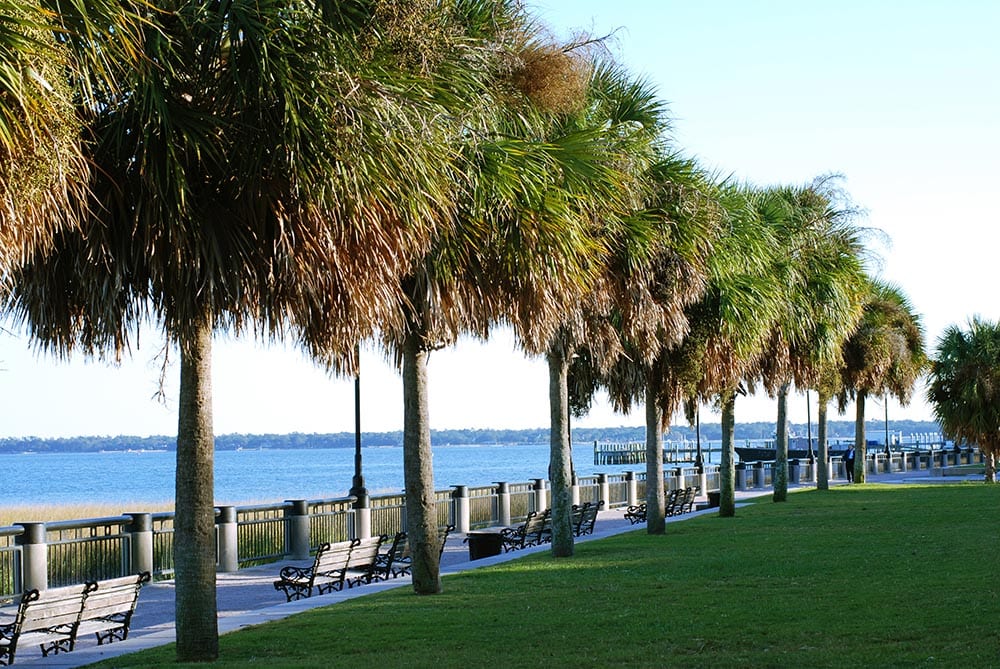
Florida is home to many species of trees, including native trees that consist of oak, cypress, maple, basswood, ash, and mahogany trees. The state also has an abundance of pine, mangrove, fruit, and gum trees.
Florida has a tropical and subtropical climate, which makes it perfect for growing trees that prefer humidity. Being a Floridian means you have a wide variety of trees you can plant in your own yard for added beauty.
In this guide, we’ll list 27 types of trees in Florida and their own specifics so that you have the information you’ll need if you want to add trees to your landscaping. We’ll list them by shade trees, fruit trees, and flowering trees.

The 27 Types of Trees in Florida
Shade Trees in Florida
Living in Florida means an abundance of sunshine, hence the Sunshine State nickname. It’s nice to have shaded trees to provide a break from the sweltering sun and heat. Here is a list of shade trees that grow well in Florida.
1. Black Olive Tree (Bucida buceras)
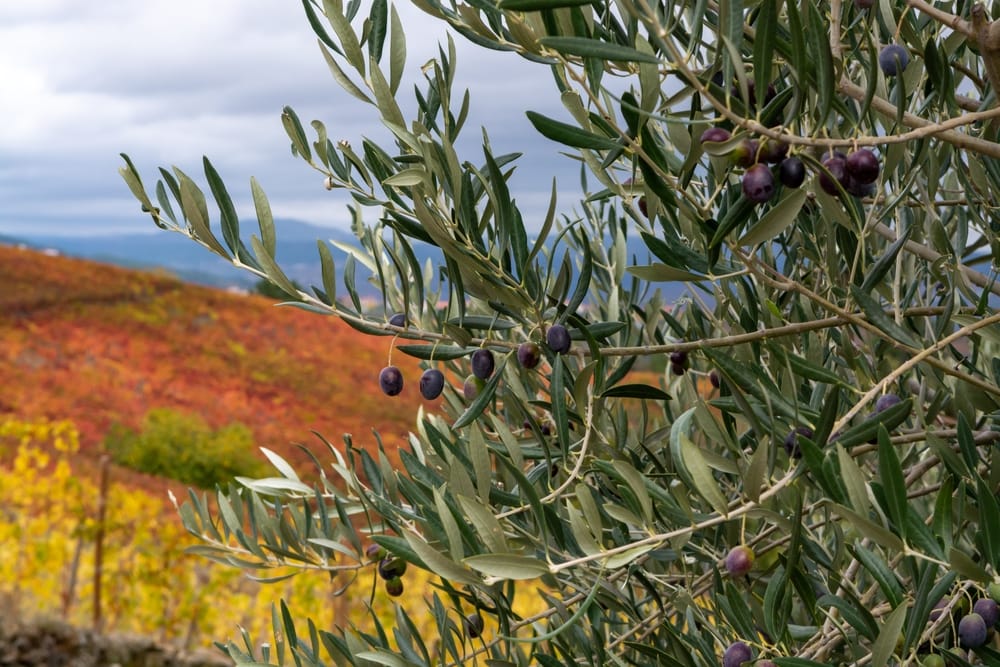
| USDA Hardiness Zones | 10b–11 |
| Sun | Full sun or partial shade |
Black Olive trees are evergreens native to the upper Florida Key region. They can grow to 40–50 feet in height, which provides ample shade. The leaves do not turn colors with the change of season, and the leaf blades grow to 2–4 inches. They also produce small black-seeded capsules. They flower yellowish to light brown blooms in the spring and summer, and they do require pruning in early spring. For best results, wait until after the second year to prune the tree.
2. Bald Cypress (Taxodium distichum)
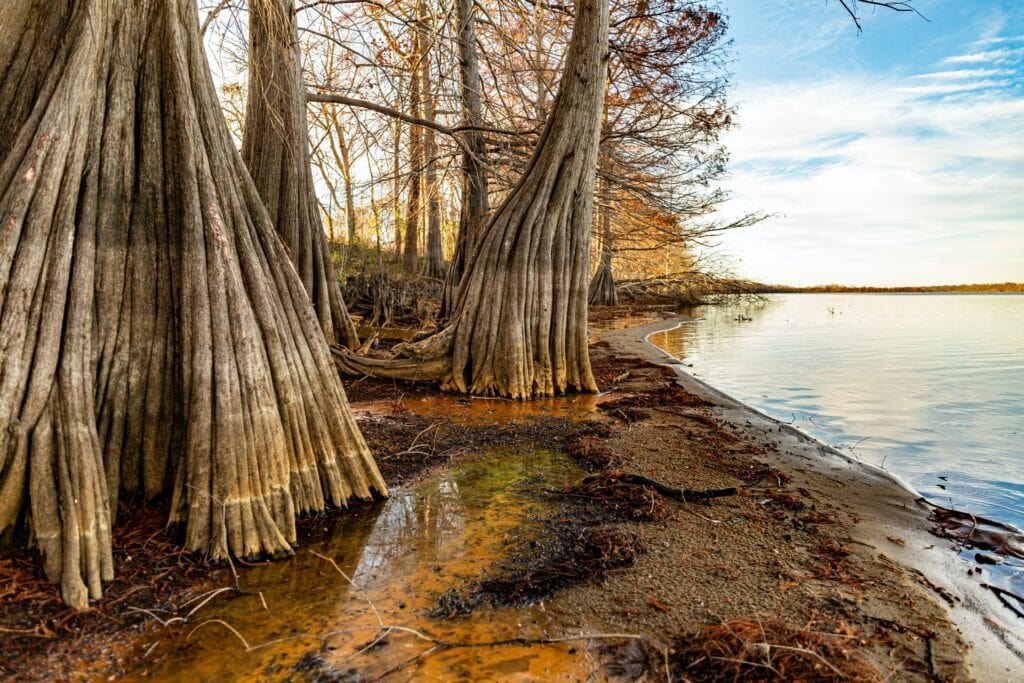
| USDA Hardiness Zones | 4–10 |
| Sun | Full sun (6–8 hours) |
Another native to Florida, these trees can mainly be found in swampy areas or any other type of wetland. These trees have a medium growth rate of 40–50 feet in roughly 15–25 years. They have a spread of 20–25 feet, and they can grow to a whopping 60–80 feet, with some reaching 150 feet in height. They can grow on dry land but do best in wet areas, like the Everglades. These deciduous trees lose their needle-like leaves in the winter, and some in the state are over 500 years old.
3. Live Oak (Quercus virginiana)

| USDA Hardiness Zones | 8B |
| Sun | Full sun |
Live oaks in Florida seem to have their own unique presence, with massive branches resembling arms that seem to reach out for you. These trees provide excellent shade and are the classic symbol of the South itself. They are often referred to as southern live oaks.
Live oak trees can live for centuries, and the wood is hefty and dense. Live oaks also add value to your property, and they can reach 60 feet in height over their lifetime. The numerous branches can stretch out the length of a football field, and they never go bare. However, they do shed leaves to make room for new growth in early spring. They also make terrific homes for wildlife, such as birds and squirrels.
4. Mahogany (Swietenia mahagoni)

| USDA Hardiness Zones | 10a–11 |
| Sun | Full sun |
Native to southern Florida, these trees can grow 40–60 feet high with a canopy of 50 feet. They are fast-growing, which makes them one of the most popular trees to plant in southern Florida. The canopy does not prohibit grass growth underneath, and they hold up to strong winds, which work well for hurricane regions like Florida. They produce capsules, known as “fruits” that split open while still on the tree, releasing winged seeds.
These trees have a massive root system, and you’ll want to plant them at least 20 feet from any permanent foundations and at least 5–6 feet from sidewalks to prevent damage.
5. Maple (Acer)

| USDA Hardiness Zones | 4a–9b |
| Sun | Full sun |
There are two species of maple trees in Florida: the red maple (Acer rubrum) and the Florida maple (Acer saccharum subsp. floridanum). The red maple showcases vibrant colors in the fall of red, yellow, and orange that last several weeks. Finding trees in Florida that change colors in the fall are few and far between, and the red maple provides an autumn feel. They can reach 60–75 feet high in maturity, with a width of 25–35 feet. Birds love this tree, as well.
The Florida maple’s fall leaf colors are yellow and orange. It has a high heat tolerance and can reach up to 60 feet tall, but the usual height is 20–30 feet. They can tolerate short droughts, and they do well in a vast amount of different soils.
6. Japanese Fern Tree (Filicium decipiens)
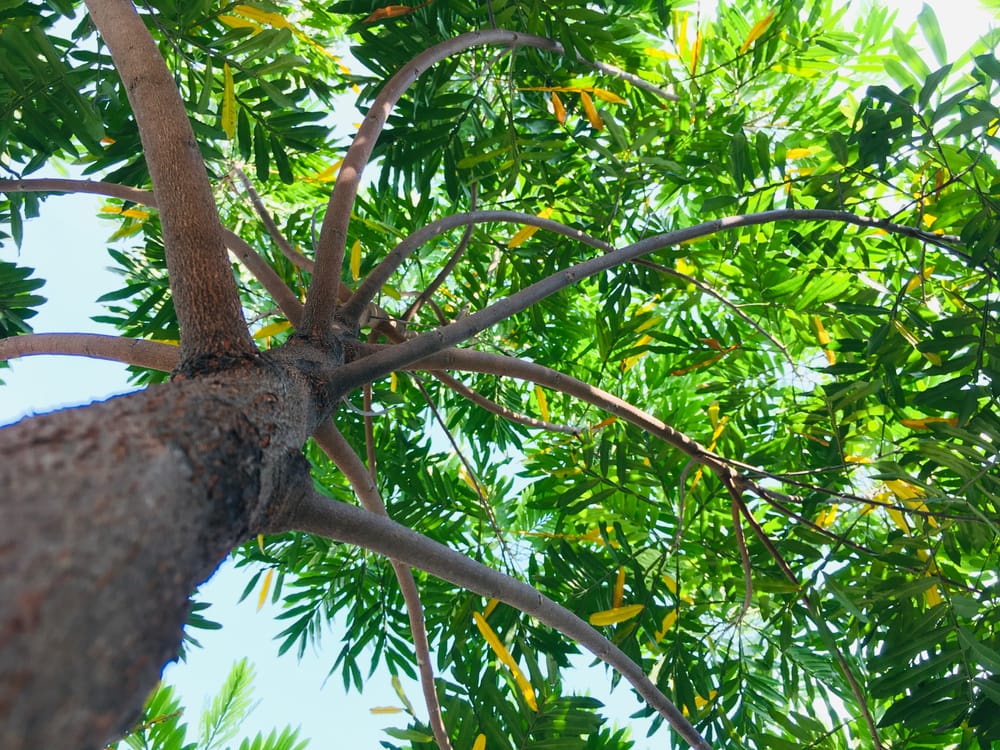
| USDA Hardiness Zones | 10a–11 |
| Sun | Full or partial sun |
The Japanese fern tree has a rounded crown with a fern-like appearance, hence the name. It’s not monstrous like some shade trees, only reaching a height of 20–25 feet. This tree is an evergreen that prefers full to partial sun and works well in smaller yards for landscaping. They do best in well-drained areas and should be planted at least 10 feet from your home so the foliage can grow and spread nicely. These trees are low maintenance and only require fertilizer in spring, summer, and fall with quality granular.
7. Gumbo-Limbo Tree (Bursera simaruba)
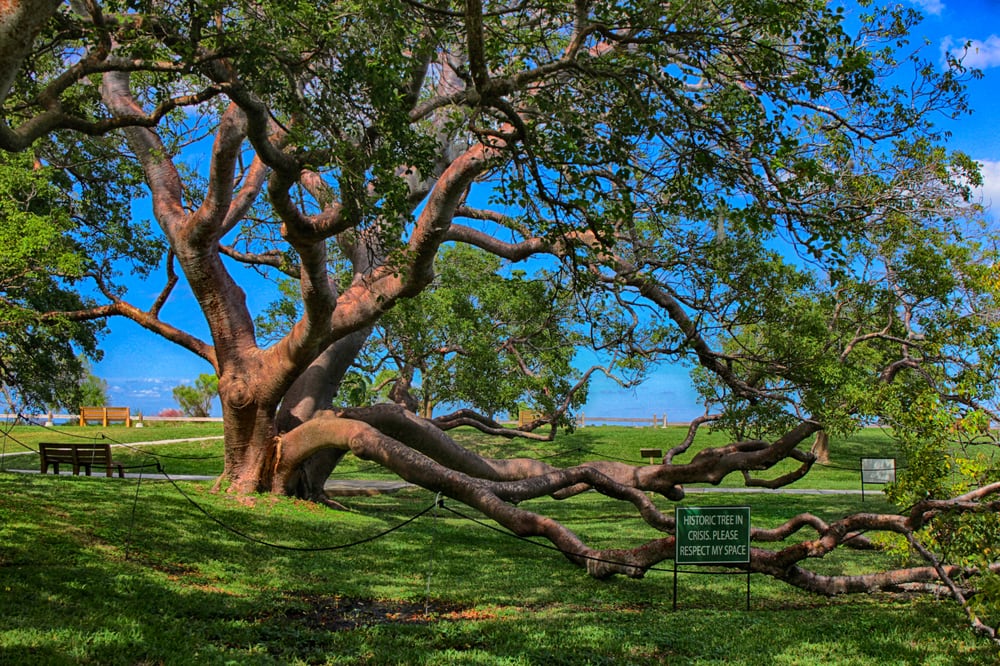
| USDA Hardiness Zones | 10–11 |
| Sun | Full sun or partial shade |
These trees are native to southern Florida and grow best in zone 10. They reach 25–30 feet tall but can reach a maximum height of 60 feet. It’s drought and salt tolerant and only needs trimming if a branch is hanging too low, which may hinder access to your home or garage. You should plant them 15–20 feet from your home to avoid root problems as the tree matures. For best results, fertilize them two or three times a year with a quality granular.
8. Florida Strangler Fig (Ficus aurea)
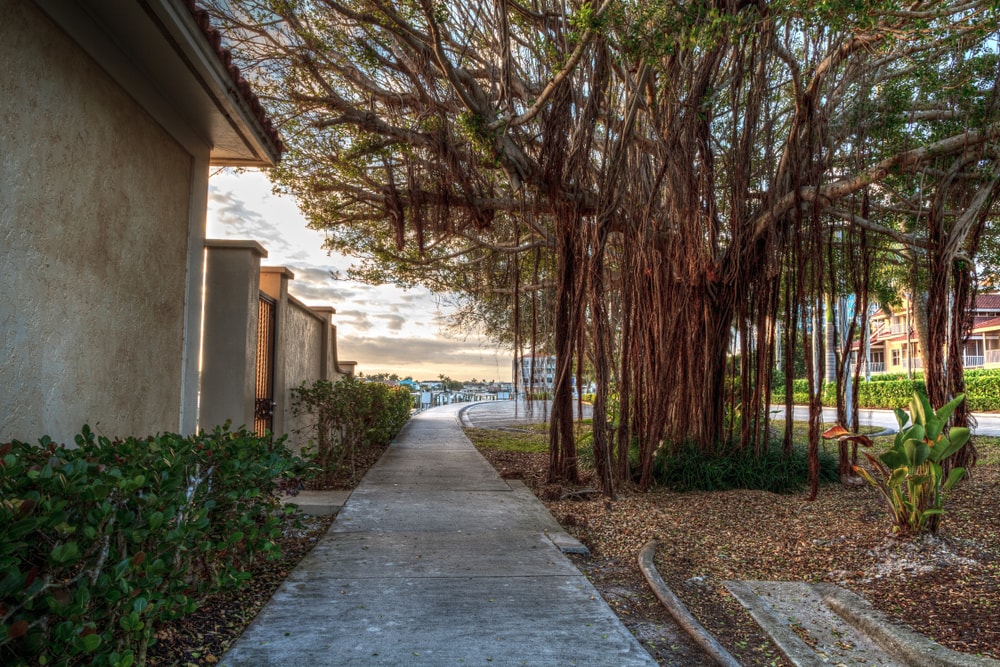
| USDA Hardiness Zones | 10b–11 |
| Sun | Full sun or partial shade |
The Florida strangler fig tree, or golden fig, is another fast grower, reaching heights up to 60 feet. It has a 50–70-foot spread, and the dark-green leaves provide dense shade.
These trees are different in that they grow from a host tree from seedlings dropped by birds and other animals. The seeds are sticky and cling to the canopy of the host tree, eventually sprouting a life all its own. The roots are on a mission to grow down the trunk and penetrate the soil below. Once they penetrate the soil, the roots thicken and become trunk-like structures with leaves. Ultimately, the host dies from strangulation, hence the name.
9. Slash Pine (Pinus elliottii)
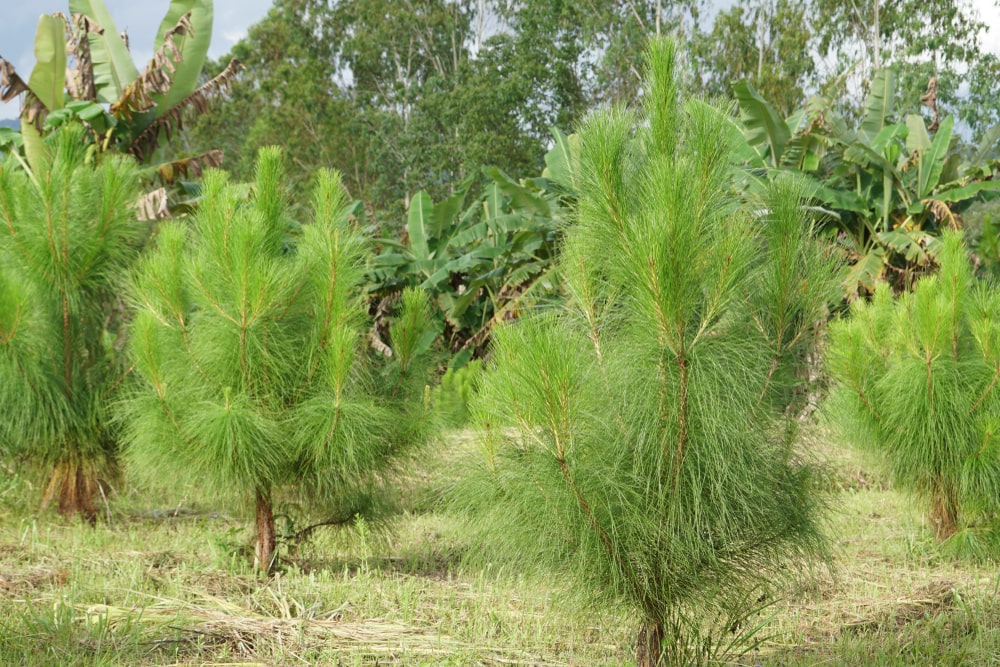
| USDA Hardiness Zones | 7a–11 |
| Sun | Full sun or partial shade |
The Florida slash pine (Pinus elliottii) is native to the Gulf Coast and the Atlantic coastal states. This multi-branch shade tree can grow anywhere from 75–100 feet in height with a 35–50-foot spread. The branches can break easily during strong winds, so plant them away from your home or any other structure.
This tree produces 6-inch pine combs, and it likes a variety of well-drained acidic soils. It has dark green needle-like leaves that are 6 inches in length, and it does not change color in the fall. This needled evergreen is fragrant, and it can produce large surface roots.
10. Loblolly Pine (Pinus taeda)

| USDA Hardiness Zones | 6b–9b |
| Sun | Full sun |
The Loblolly pine is a massive tree reaching heights between 50–80 feet but is capable of reaching 150 feet tall. It produces cones that are between 3–6 inches long with sharp spines. The evergreen needles are 6–9 inches long and turn light green or brownish color in the winter. It has a large canopy that provides ample shade with reddish-brown bark.
Fruit Trees in Florida
There’s nothing better than having the ability to walk out onto your lawn and grab some fresh fruit from a fruit tree, and when you live in Florida, you have plenty of options and varieties of fruit you can plant. Here is a list of common fruit trees that do well in the Sunshine State.
11. Banana Tree (Musa acuminate)
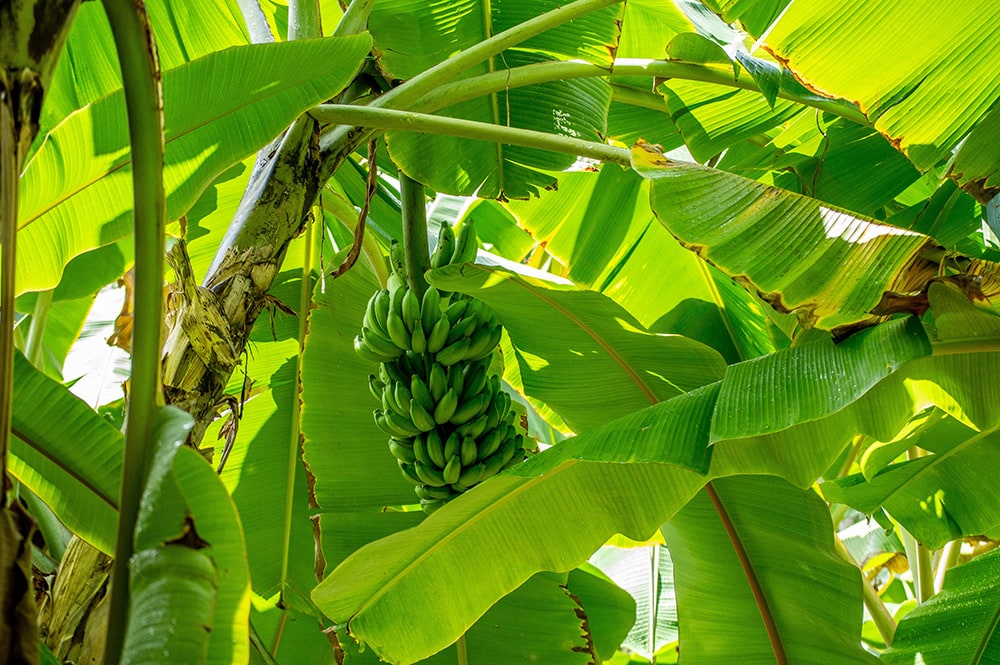
| USDA Hardiness Zones | 4–11 |
| Sun | Full sun |
There are a few types of banana trees and plants, but the one that does the best in Florida is the Dwarf Cavendish (Musa acuminate). Some areas of Florida may have a bout or two of frost, but that possibility diminishes the farther south you go in the state. Frost may prohibit new growth come springtime, so it’s best to plant these if you live in the southern part of the state.
They need moist soil to thrive, and they will also need to be fertilized four to six times a year due to the sandy soil that is common throughout Florida. They grow to 3–10 feet tall, and you can grow them indoors or outdoors.
12. Jackfruit (Artocarpus heterophyllus)
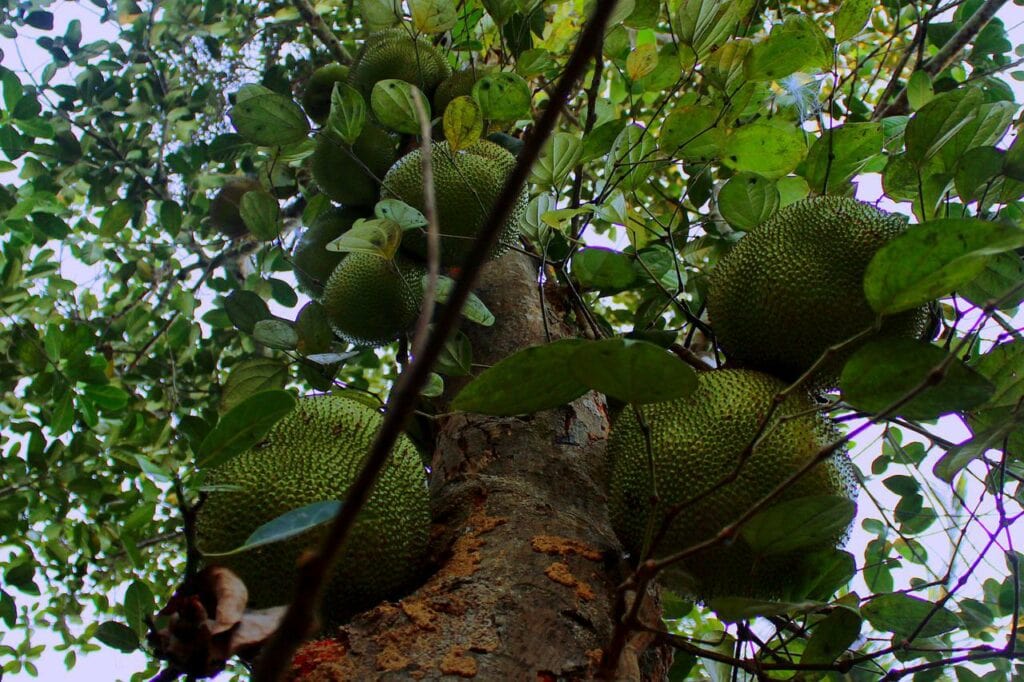
| USDA Hardiness Zones | 10–12 |
| Sun | Full sun |
The jackfruit loves tropical climates, making it a perfect fruit tree to grow in Florida. They can grow 30–40 feet but can grow to 60 feet, and they have leathery, dark leaves. This deciduous tree is part of the fig, breadfruit, and mulberry family and is the largest edible fruit globally. They prefer well-drained soils and can handle windy conditions.
13. Citrus Trees
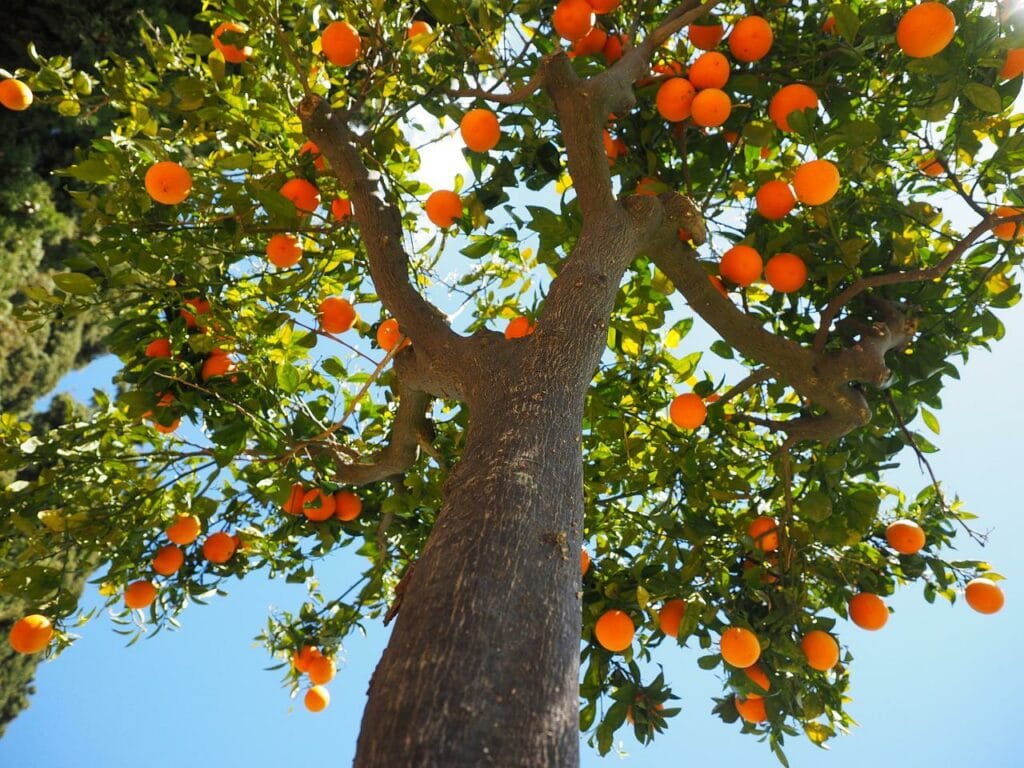
| USDA Hardiness Zones | 9–10 |
| Sun | Full Sun |
Citrus trees also love subtropical climates, and they are easy to grow. They can tolerate light shade but prefer full sun. You can choose what type of citrus tree you want to plant, and the type will depend on the part of the state you live in. Tangerines, lemons, limes, oranges, grapefruits, tangelos, and kumquats should be planted in zones 9–10. If you live in the northern part of Florida, you may need to plant them in containers for the tree to flourish and avoid frost.
14. Loquat (Eriobotrya japonica)
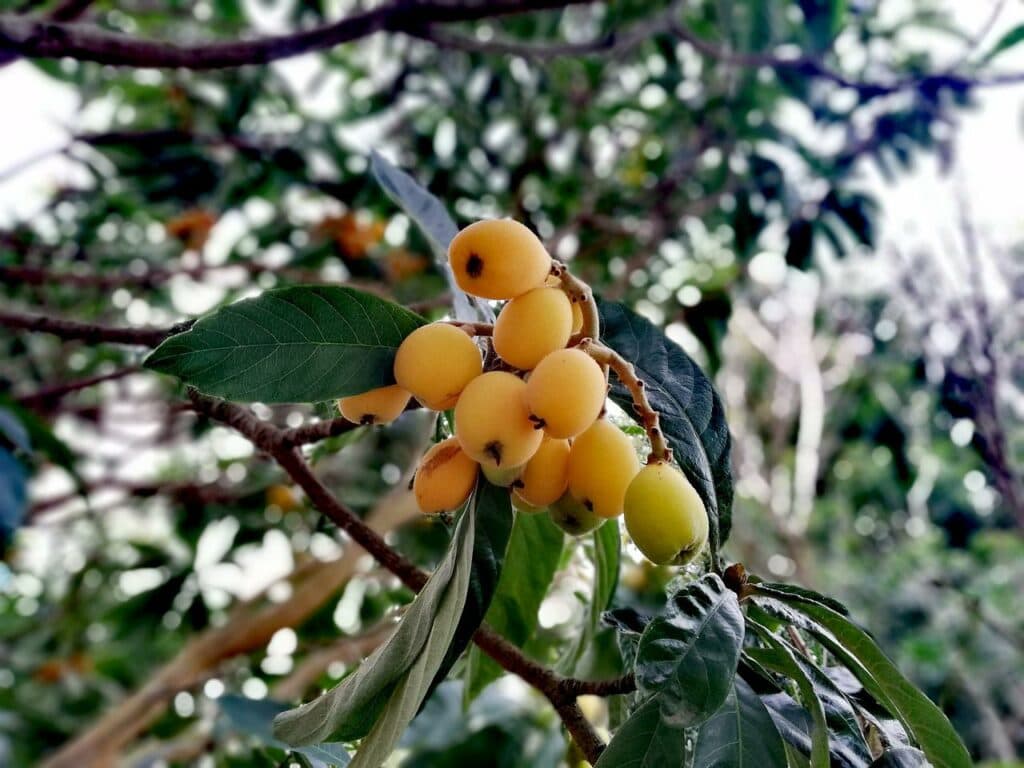
| USDA Hardiness Zones | 8–10 |
| Sun | Full sun |
The loquat, also called the Japanese medlar, can grow 15–30 feet tall and grows fast; it can grow 3 feet in a year. Pruning can keep the tree at 6–12 feet tall, and they are cold tolerant, which makes them perfect for growing anywhere in Florida. They can grow in sandy soil, which is common in Florida, but they need well-drained soil for the best results. This evergreen has an upright canopy, and the bright orange fruit contains many health benefits.
15. Figs (Ficus carica)

| USDA Hardiness Zones | 8–10 |
| Sun | Full sun |
Fig trees do well in zones 8–10, but they can also tolerate colder climates in zones 6–7 with protection. They are easy to grow in central, north, and south Florida. These trees usually grow to roughly 15 feet in height and width, and this deciduous tree can produce fruit twice in the same year. There are four types of figs: celeste, brown turkey, jelly, and green ischia, with celeste being the most common in Florida. The celeste fig produces a small purplish fruit that is juicy and delicious.
16. Lychee (Litchi chinensis)
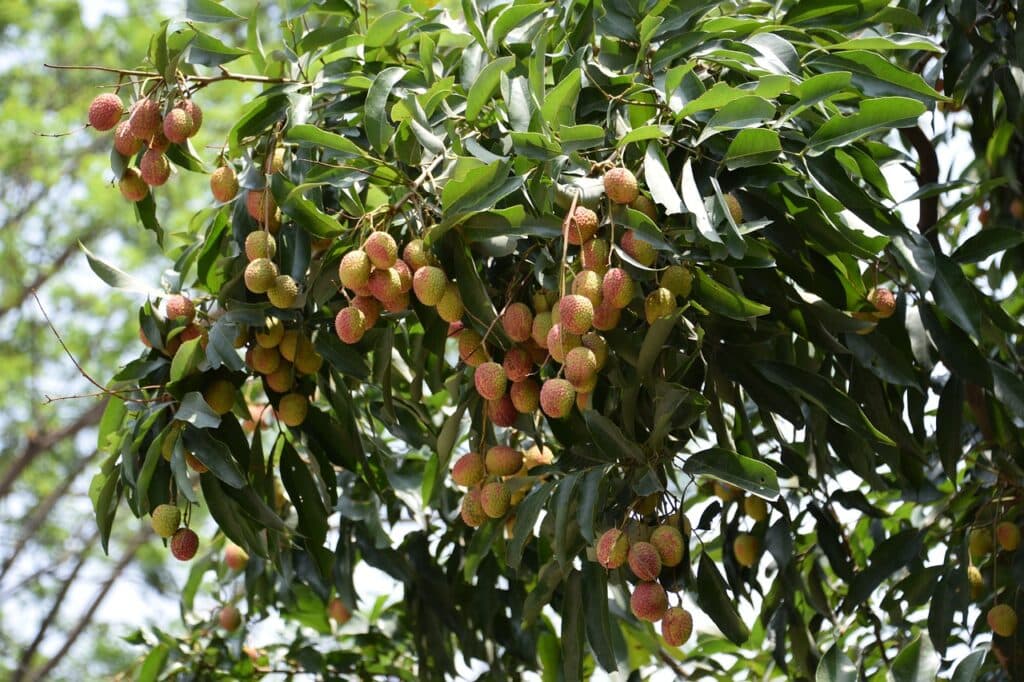
| USDA Hardiness Zones | 10–11 |
| Sun | Full sun |
The lychee tree grows best in well-drained soil, and the fruit it produces looks like strawberries. You have to peel the outer skin to get to the edible part of the fruit, and the inner edible portion is clear, sweet, and delicious. Trees can grow to 40 feet, and the fruits grow in clusters of three to 50 in the summertime. They grow the best in southern Florida due to possible freezing temps in the northern part of the state, which they cannot tolerate.
17. Guava (Psidium guajava)
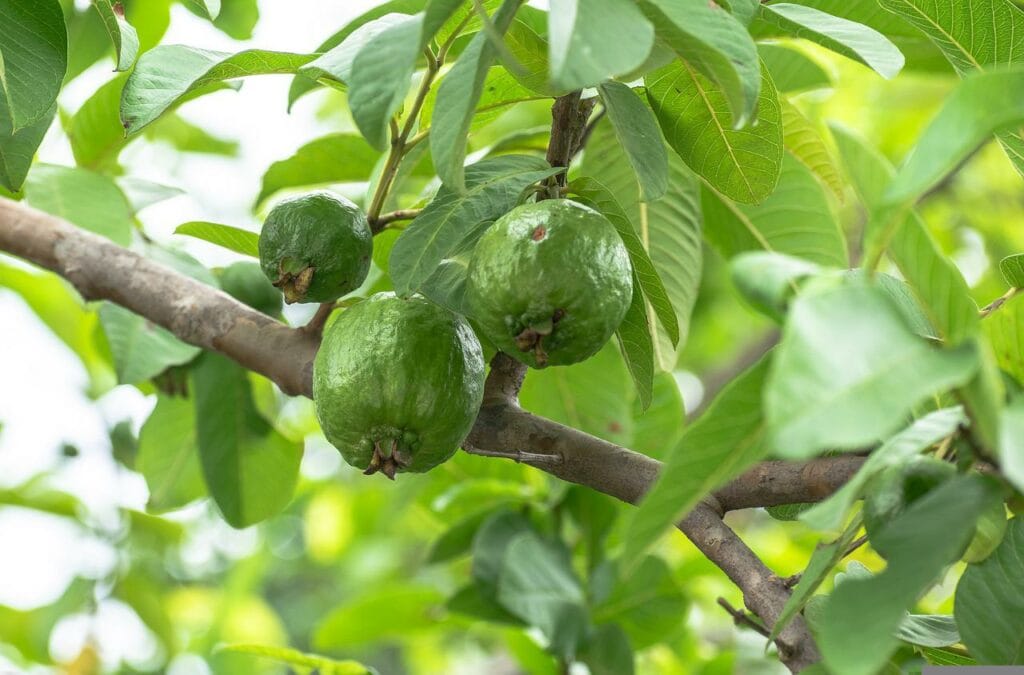
| USDA Hardiness Zones | 9–12 |
| Sun | Full sun |
There are many different types of guava, and if you want to plant a guava tree in Florida, the best ones are Mexican Cream, Red Indian, and Homestead. These trees do well in central and south Florida and produce red, pink-fleshed, and white-fleshed fruit. These trees can be single or multi-trunk and grow to 20 feet tall. We should note that guava is considered invasive in South Florida.
18. Mulberries (Morus alba)
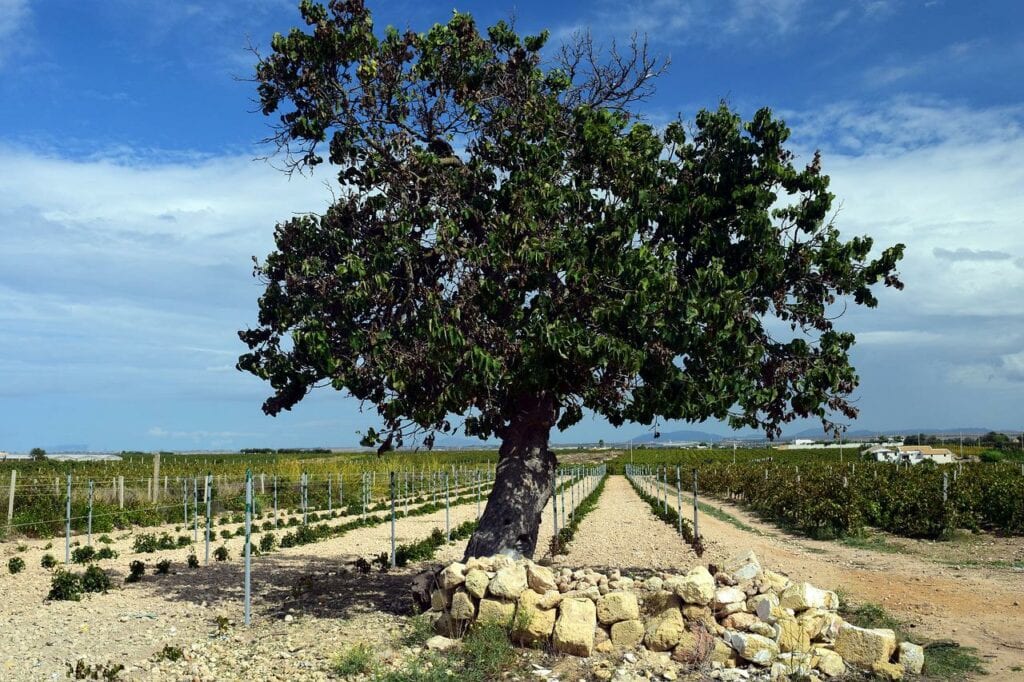
| USDA Hardiness Zones | 5–10 |
| Sun | Full sun or light shade |
Mulberry trees produce sweet, small fruits that resemble blackberries. Humans are not the only ones that like the taste of this sweet fruit—outdoor critters love it, too, and make growing this deciduous tree a challenge. They love sandy soils, are drought-tolerant, and can handle full sun to part shade. These trees are fairly easy to maintain, as they require very little pruning and irrigation once established. They can grow from 40–60 feet tall.
Flowering Trees in Florida
Any Floridian knows that the Sunshine State does not have that autumn feel, as most of the leaves do not change color. However, let’s look at flowering trees that give some color that add to the greenery that is common in Florida landscapes.
19. Crabapple Tree (Malus angustifolia)

| USDA Hardiness Zones | 8–9 |
| Sun | Full sun or partial shade |
Crabapple trees only grow in the Florida Panhandle. These deciduous flowering trees have showy pink blossoms that add beauty to any landscaping. The flowers have five petals and are borne in clusters of three to five. These trees bloom in early spring and give off a pleasant scent. They require full to partial shade and grow to 30 feet with a 20-foot spread. These trees are not salt tolerant.
20. Crape Myrtle (Lagerstroemia indica)
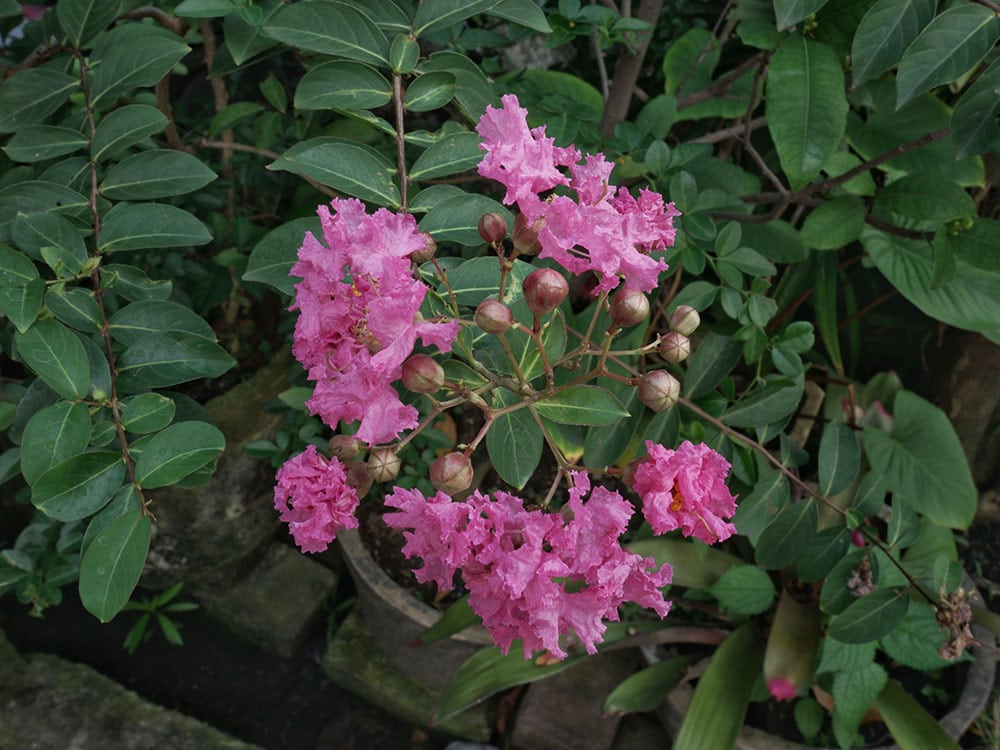
| USDA Hardiness Zones | 6–10 |
| Sun | Full sun |
Crape Myrtles are one of the most popular trees to have in Florida. Commonly referred to as “the lilac of the South,” these trees are low-maintenance and are disease and pest-free. The crape myrtle has large blooms that can last over 100 days in the spring and early summer, and they come in an array of colors: white, purple, red, light pink, lavender, and dark pink. They can grow to 10–30 feet tall.
21. Hydrangea (Hydrangea arborescens)
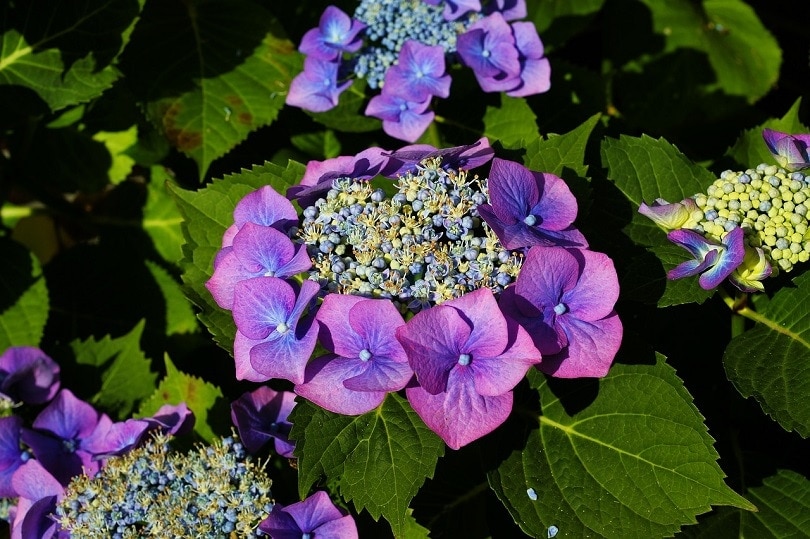
| USDA Hardiness Zones | 3–7 |
| Sun | Partial sun or partial shade |
The gorgeous hydrangea loves morning sun followed by afternoon shade. Hydrangeas are really shrubs rather than trees, but we couldn’t exclude them due to their beauty. They require well-drained, fertile soil and can grow several feet in height. There are two kinds: mop heads and lace caps. Both bloom beautifully, with lace caps being the more elegant of the two.
22. Dogwood (Cornus florida)
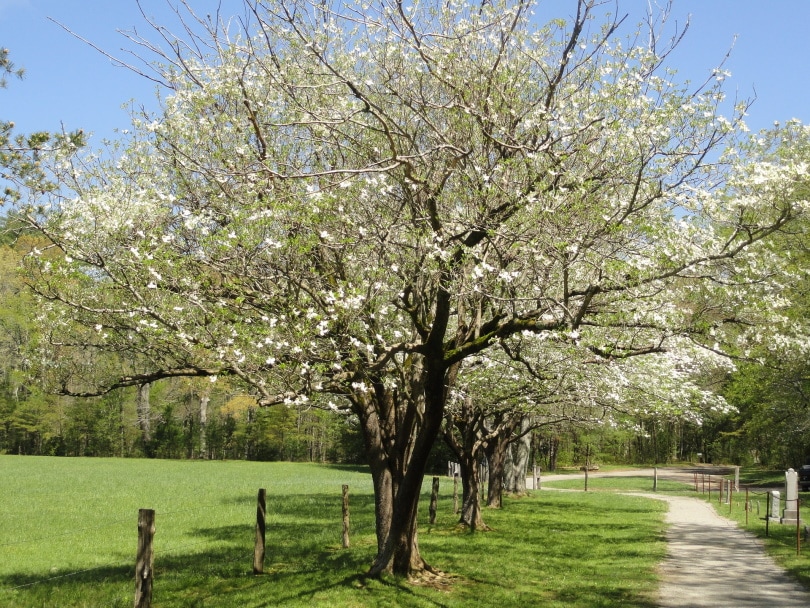
| USDA Hardiness Zones | 5–9 |
| Sun | Part sun or shade |
The dogwood tree can be found in North Florida, with growths up to 35 feet tall. They do well with slightly acidic, well-drained soils and need partial or filtered sun. They need plenty of water and are not drought resistant. The dogwood blooms with white flowers in spring, and the leaves turn red in the fall. It can grow with a single trunk or multi-trunk with training.
23. Plumeria (Plumeria alba)
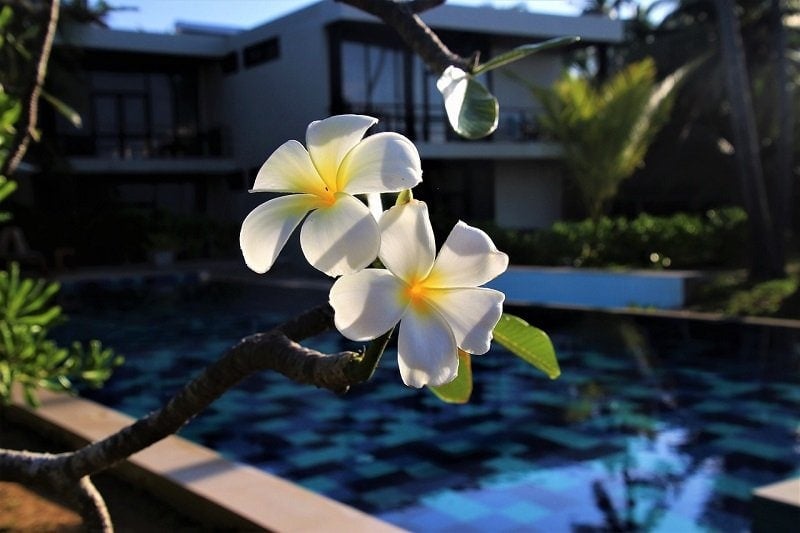
| USDA Hardiness Zones | 10–11 |
| Sun | Full sun |
The plumeria tree grows well in south and central Florida. Also known as the Temple Tree or frangipani, it blooms fragrant flowers that can be red, yellow, pink, or white, and they bloom from spring through summer. They are considered shrubs or small trees and add lovely color to your landscaping. They need well-drained, acidic soil and can grow to 10–15 feet.
See also: How to Root Plumeria Cuttings (12 Expert Tips)
24. Bottlebrush (Callistemon citrinus)
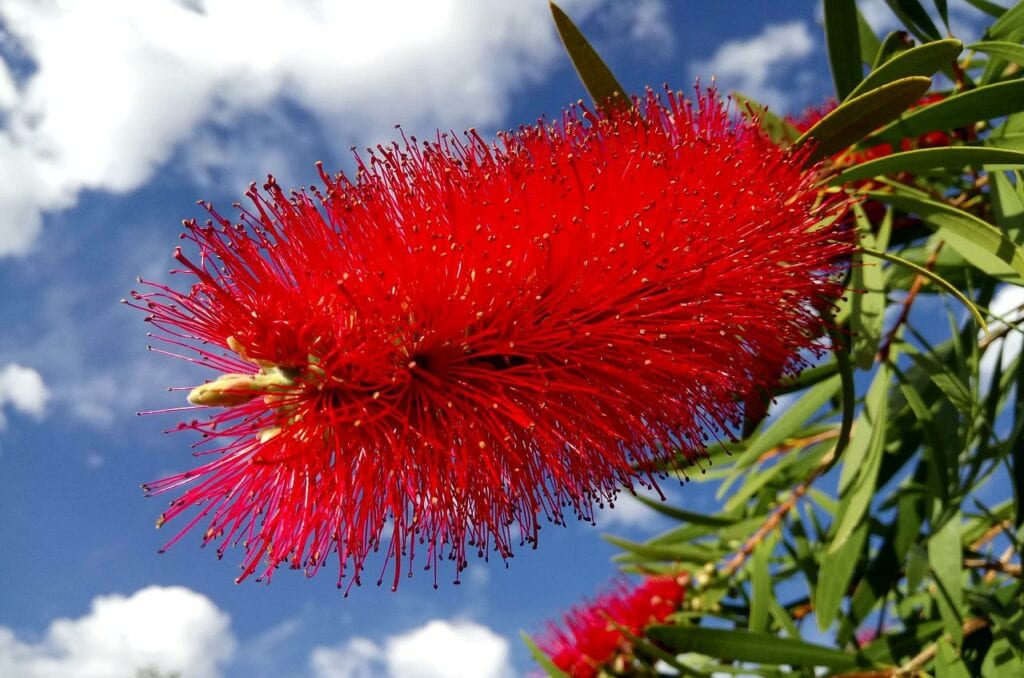
| USDA Hardiness Zones | 9a–11 |
| Sun | Full sun |
The Bottlebrush blooms with red spikes that attract hummingbirds and butterflies. It can be sold as a shrub. However, it can grow as a tree, reaching 25 feet in height. This upright tree has a weeping form, and it requires full sun. It can also handle a variety of soils. It is drought and salt tolerant.
25. Magnolia (Magnolia grandiflora)
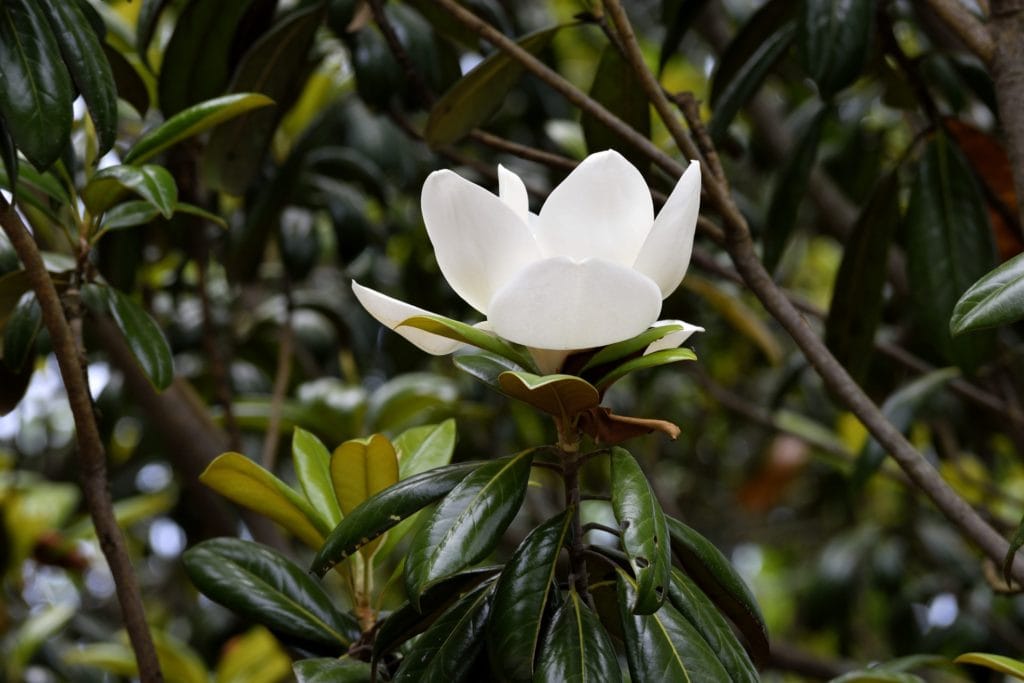
| USDA Hardiness Zones | 7–10 |
| Sun | Full sun or light shade |
Magnolia trees can grow anywhere in Florida, reaching up to 40 feet tall. They have slow growth with an oval-shaped canopy and bloom large, white fragrant flowers primarily in the spring, with occasional blooms in the summer and fall. The large white flowers contrast elegantly against its dark-green leaves, and you only need to prune low branches from the trunk.
26. Buttonbush (Cephalanthus occidentalis)
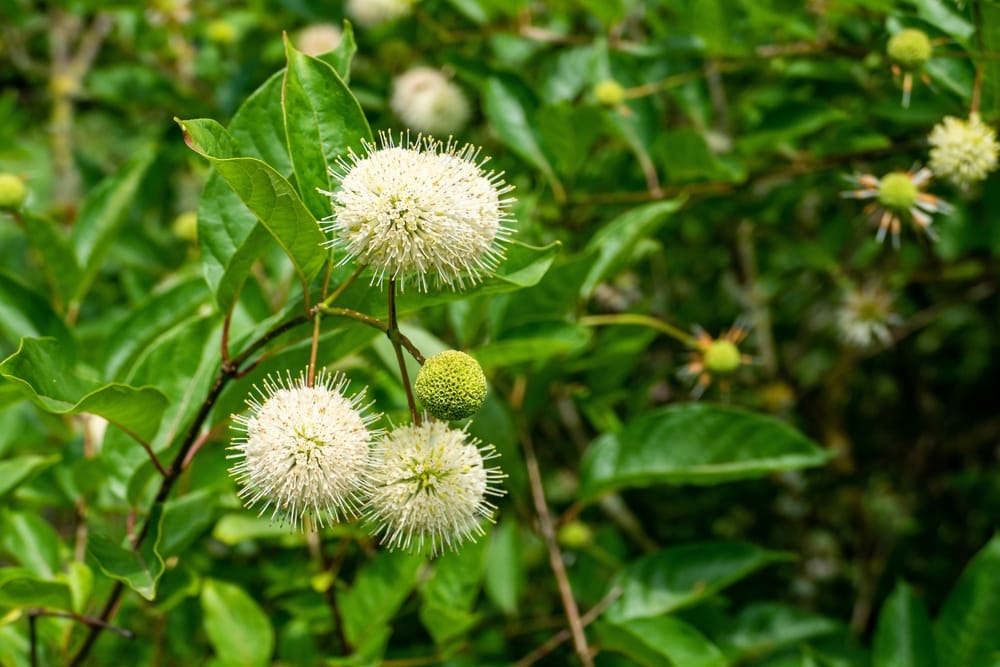
| USDA Hardiness Zones | 5–11 |
| Sun | Full sun or part shade |
The buttonbush can grow as a shrub or small tree. It can grow to 10–20 feet, losing its leaves for 1–2 months in the wintertime. It blooms in small white flowers in early spring and late summer and grows around stream banks, swamps, and ponds throughout the state. It prefers moderate to wet soil and needs full to partial shade.
27. Palm Trees (Arecaceae)
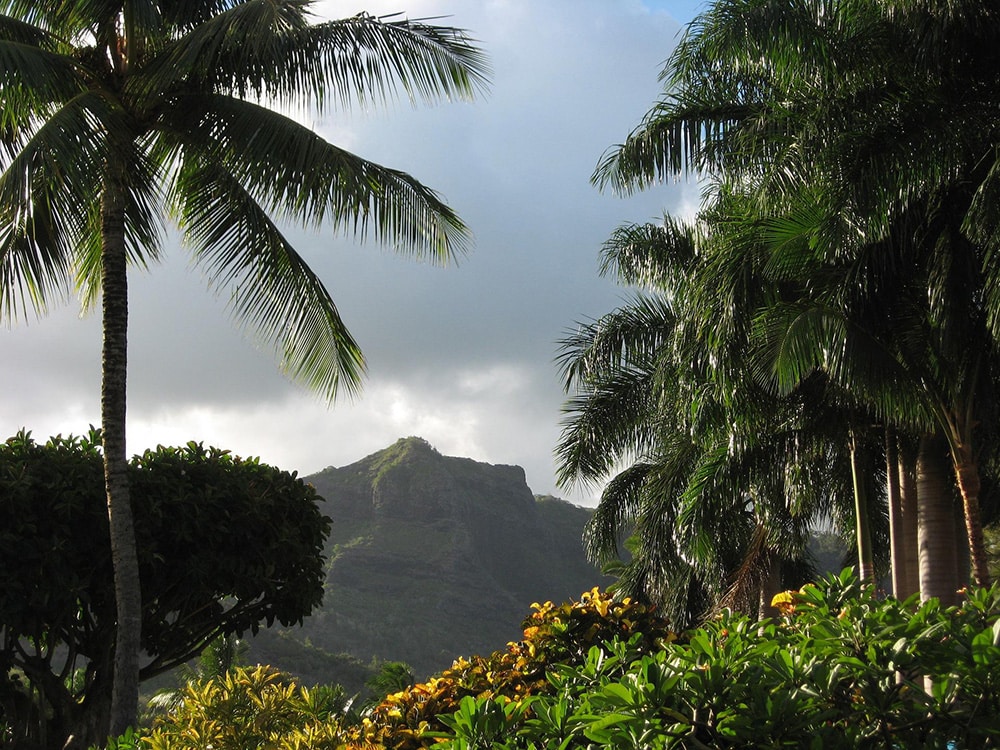
| USDA Hardiness Zones | 8–11 |
| Sun | Full sun |
We’ve saved the obvious for last. When you see palm trees, you know you’re in Florida. There are many different types of palm trees, and they can be found all throughout the state. They belong to the Palmae family and grow to 30–50 feet with slender stems and large evergreen leaves that either fan out or are feather-shaped.

Conclusion
Whether you live in Florida or visit occasionally, we hope our list has taught you how to spot the many different tree types in this tropical climate. From native, flowering, and fruit trees to shade trees, the options are limitless and add excellent décor to any landscaping.
Featured Image Credit: kuch, Shutterstock
Contents
